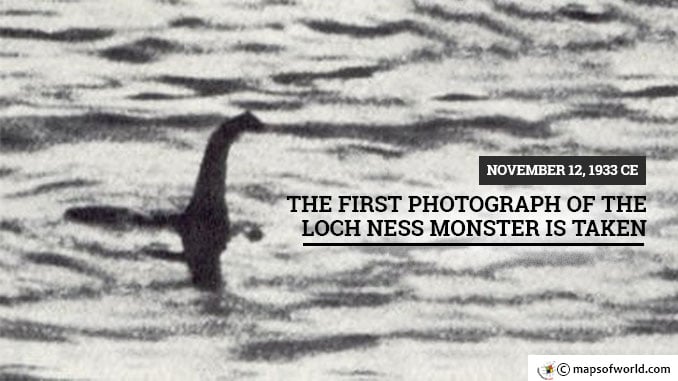Walking along the River Foyers after attending church, Hugh Gray managed to be the first to capture photographic evidence of Scotland’s enduring mystery — the Loch Ness Monster — on November 12, 1933. Though purported sightings date as far back as the 6th century, none brought with them the ability to truly visualize the moment of encounter the way Gray’s picture did. The unfocused image sparked a phenomenon that continues to mesmerize people all over the world to this day. The summer of 1933 is when the modern fascination with “Nessie” began, as a raft of sightings were reported along the roads bordering Loch Ness, the massive freshwater lake 20 miles to the southwest of Inverness. In late July, George Spicer and his wife reported seeing “a most extraordinary form of animal” shuffle across the pavement and into the water. Weeks later, motorcyclist Arthur Grant described a similar scene, this time in the middle of the night. Noting the beast seemed to be some sort of cross between a sea-dwelling dinosaur and seal, Grant’s account has since been discounted as a means to explain away a late-night accident. On November 12, 1933, however, tales of the Loch Ness Monster shifted from hearsay to plausible. Gray strolled along the River Foyers near the southern edge of the lake, as was his custom on Sunday afternoons. With near-perfect visibility thanks to stunning clear skies, he noticed some “object of considerable dimensions” push up above the surface. Taken aback by the size of it, he took a series of pictures in an attempt to record the sighting. Of the handful of photographs he took, only one would end up passable — a blurred image of a hump in the water. Swearing by his account, Gray made international headlines. He described the events in detail several times for The Daily Record and a variety of authors, submitting the negatives to scientific examination to prove they were not forgeries. The photo, published in newspapers throughout Britain, ran alongside his description of “an animal with a body like a whale, a head like a seal, and an elongated tail” early in December. Within months, Gray’s photo was trumped by a now-famous picture of a small head and slender neck protruding above the water. The “Surgeon’s Photograph,” said to have been taken on April 21, 1934 by Dr. Robert Wilson of London, would later be exposed as a fake. Despite being designated a fraud, it is the image most people associate with the Loch Ness Monster. Gray, for his part, remained true to his story for the rest of his life, never wavering from the original tale of his experience on that bright afternoon decades before. Also On This Day: 764 – Tibetan troops take Chang’an, the capital of the Tang Dynasty in China, for fifteen days 1905 – Norwegians vote to keep monarchy as the primary form of government instead of the republican model 1927 – Joseph Stalin takes control of the Soviet Communist Party by expelling Leon Trotsky and sending into him into exile 1990 – Tim Berners-Lee publishes a formal proposal for a World Wide Web to CERN 1996 – A Saudi Arabian Boeing 747 and Kazakh Ilyushin Il-76 collide in mid-air near New Dehli, killing 349
November 12 1933 CE – The First Photograph of the Loch Ness Monster is Taken

